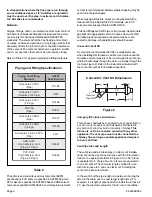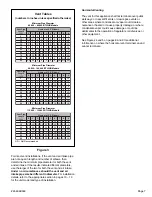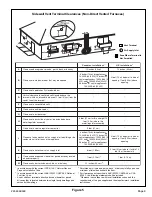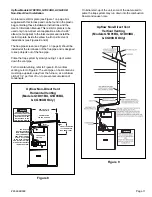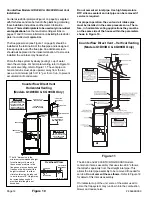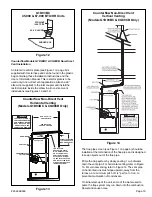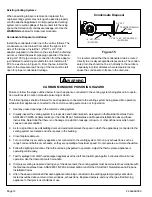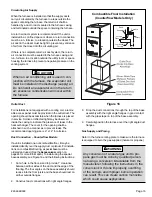
# 45466K003
Page 20
OPERATION
Sequence of Operation
Heating
During a call for heat the thermostat closes the R-W
circuit of the control board. The control board verifies limit
switches are closed and pressure switch is open. The
induced draft blower relay closes causing the blower to
run. As vent pressure is developed by the induced draft
blower, the pressure switch closes. After a 15-second pre-
purge, the control energizes the hot surface ignitor. After
the 7-second warmup time, the control energizes the main
gas valve causing the main burners to ignite. The hot
surface ignitor is de-energized 3 seconds after the main
valve opens. If flame is sensed during this time the main
valve remains energized and the control starts the
30-second heat blower
“
on
”
delay.
As heating demand is met, the thermostat de-energizes the
R-W circuit. The control de-energizes the main valve
causing the burners to shut off. The induced draft blower
shuts off after a 15-second post-purge delay. The circulating
air blower will continue to operate until the user-selectable
heat blower
“
off
”
delay expires. The control return to standby
mode once the heat blower
“
off
”
delay expires.
Fan “On”
During a fan
“
on
”
call, the thermostat energizes the R-G
circuit of the control board, immediately causing the fan to
energize the COOL speed. The fan remains energized as
long as the thermostat calls for fan
“
on
”
operation.
If a call for cooling is energized during a fan
“
on
”
call, the fan
continues to operate at the COOL speed. If a call for heat is
energized during a fan
“
on
”
call, the control de-energizes the
fan immediately and begins the heat call/ignition sequence.
At the end of the fan
“
on
”
call the thermostat de-energizes
the R-G circuit of the control, causing the fan to be de-
energized immediately.
Cooling
During a call for cooling, the thermostat energizes the R-Y
circuit of the control board. After a 1-second cooling
“
on
”
delay, the control energizes the cooling fan speed. If the fan
is already energized, it remains running and does not de-
energize for the 1-second cooling fan
“
on
”
delay.
The call for cooling has priority over continuous fan
operation while a call for heating has priority over both a
call for cooling or continuous fan. Ignition lockouts for any
reason do not affect cooling operation.
As cooling demand is met, the thermostat de-energizes
the R-Y circuit of the control board. After a 60-second
cooling
“
off
”
delay, the control de-energizes the cooling
speed fan. At the end of the cooling
“
off
”
delay period, the
control returns to the standby mode.
Controls
Following is a description of the operation of some of the
controls used in this furnace. All models use one of each
control, except as noted.
Pressure Switch
The pressure switch is a normally open switch that
monitors combustion air flow. Inadequate air flow resulting
from excessive venting system restriction or a failed
combustion blower will cause the switch to remain open.
Rollout Switch
The rollout switch is a normally closed switch that opens
when abnormal temperatures exist in the burner area. This
can be caused by a restricted heat exchanger causing
main burner flame to
“
roll out
”
into the vestibule area or
burner box.
This switch must be manually reset by pushing the button
on top to restore furnace operation. G1D93BC units have
two rollout switches.
Primary Limit Control
This is a normally closed control that opens if abnormally
high circulating air temperatures occur. It is an automatic
reset control.
Auxiliary Limit Control
This is a normally closed control that opens under abnor-
mal
“
reverse air flow
”
conditions that could occur in a
counterflow or horizontal installation if the circulating
blower fails. It is an automatic reset control.
Upflow models do not include an auxiliary limit control.
Interlock (Blower Door) Switch
When the blower door is removed, the interlock switch
breaks the power supply to the burner controls and blower
motor. The switch operation must be checked to confirm it
is operating correctly.
Blower Control Board
The blower control board operates the circulating air
blower, the combustion blower and any accessories
connected to it. These models feature user-selectable
blower
“
off
”
delay times (60, 90, 120, and 180 seconds)
that are factory set to provide a 120-second blower
“
off
”
delay on heating (see wiring diagram on page 26).

